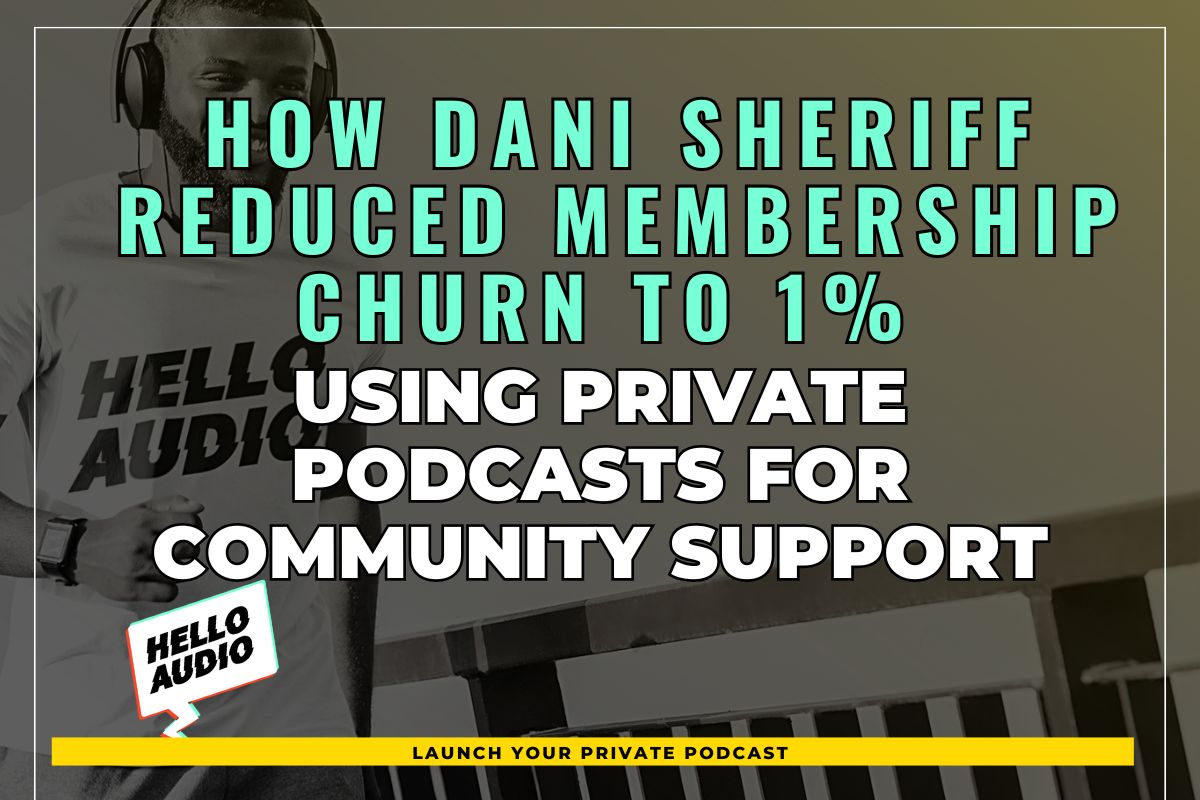With 77% of users joining to “discover new things,” online communities have emerged as major hubs for connection, collaboration, and knowledge sharing.
Thanks to these virtual spaces, building relationships with people across continents, you might never otherwise meet isn’t a pipe dream anymore.
Who wouldn’t want to get ten times the global exposure at a fraction of traditional marketing costs? But the bigger question is: where do you start? Let us walk you through seven core steps and actionable strategies for building an online community.
TL;DR – How to Create an Online Community
Here’s how you can build an active online community:
- Identify your goals and target audience
- Choose a platform for your community
- Identify key internal stakeholders for the community.
- Set up your community
- Publish content and updates
- Encourage interaction and participation
- Moderate your community
When choosing the right platform and channel, engaging your community with audio-first marketing is a great strategy. Sign up for a 7-day free trial and create high-quality private podcasts with Hello Audio.

What is an Online Community?
An online community (aka internet community) is a virtual gathering where members engage and interact mainly through online platforms. These platforms include discussion boards, social media groups, specialized websites, etc.
An online community’s distinguishing feature is its members’ shared interests, goals, or identities. These elements create a sense of connection and belonging even with zero geographical proximity.
Why Build an Online Community?
Creating an online community has many benefits, such as:
-
Better Audience Engagement
Online communities promote more in-depth public participation compared to standard one-way advertising channels. Members can actively participate in discussions, provide feedback, and collaborate on projects. Your audience’s enthusiasm & efforts help build genuine, stronger brand relationships.
-
Raising Brand Awareness
Through member interaction and content sharing, brand communities attract potential customers and create organic buzz. Online community management can significantly increase your brand’s reach and visibility.
-
Enhanced Customer Loyalty
Virtual communities help closely connect with customers, answer questions, offer assistance, etc. Active community engagement can boost customer loyalty and advocacy.
-
Important Feedback and Insights
Communities make learning about the audience’s wants, requirements, and pain points easier. Product development, marketing plans, and general business decisions can all benefit from such vital insights.
-
Talent Acquisition and Retention
Lastly, professionals nowadays seek a positive working atmosphere to interact, learn, and develop without barriers. That said, managing successful virtual communities can draw in and retain top talent. This is especially useful for niche-specific brands and remote teams.

What Makes a Good Online Community?
Thriving online communities don’t just appear out of thin air. They are carefully maintained environments that promote involvement, support, and a sense of belonging. Let’s look at the key elements that make an online community thrive:
- A common, shared purpose (unifying theme, passion, goals, mission, etc.).
- Active engagement among members through discussions, content, and mutual support.
- Clear guidelines & active moderation ensures a safe space for diverse voices.
- Relevant, informative, engaging content to spark dialogue and keep members coming back.
- Strong leadership for direction, communication, and managing resources effectively.
- Continuously adapting to changing needs/interests to sustain engagement and relevance.

How to Build an Online Community in 7 Steps
Creating an active virtual community is a challenging job. You shouldn’t just create a platform and expect members to show up.
It requires careful preparation, planned execution, and continual engagement. This step-by-step guide will teach you how to create an engaging online community where your target audience will love to join, share content, and engage.
Step 1 – Identify Your Goals and Target Audience
You need to know what you’re building before laying the foundation. Narrow down to your community’s core purpose:
- Why does it exist?
- What will members get by joining?
- What are your long-term community goals?
Once you’ve defined your concept, pinpoint your target audience. You can better target your content and engagement strategies with a clearer understanding of their demographics, interests, and pain points.
Step 2 – Choose a Platform for Your Community
Every online community platform has pros and cons. While choosing, look at its feature-richness, accessibility, integration with current tools, and scalability.
Among our top choices are social networking groups (Meta apps, X), forum software, and specialized community platforms like Hello Audio, Mighty Networks, and Discourse.
Select a platform that fits your goals, target demographic, and accessible technical support.
Step 3 – Identify Key Internal Stakeholders for the Community.
A successful online community is a product of continuous, collaborative effort. Determine which internal stakeholders will contribute to its growth and management.
This can involve:
- Content creators
- Community managers
- Moderators, and
- Customer service staff
Clearly define duties and responsibilities so everyone knows how they contribute to the community’s growth and success.

Step 4 – Set Up Your Community
Now that your team, platform, and goals are set, it’s time to create your virtual community from scratch.
Start with an intuitive and aesthetically pleasing interface that accurately represents your brand. You must –
- Attract users’ interest by establishing community guidelines.
- Pre-populate the community feed with introductory content.
- Provide easy navigation.
Step 5 – Publish Content and Updates
Any online community needs trending, snippy content to survive. Here’s how you can create that –
- Create a content calendar with numerous formats, including blog entries, discussions, polls, and live streaming.
- Provide informative data, helpful tools, or engaging content tailored to your target audience’s interest.
- Maintain a steady posting schedule to keep members coming back for more.
Step 6 – Encourage Interaction and Participation
Communities can’t survive without active members; adopt engagement-boosting features and strategies to avoid that.
- Schedule member/admin introductions, moderate Q&A sessions, and organize prizes/giveaways.
- Actively participate in trending feed discussions.
- Recognize and reward currently active members to motivate the non-dormant ones to contribute.
Step 7 – Moderate Your Community
Online communities struggle to maintain a friendly and open environment without clear rules and active moderation. Convey your community’s rules and expectations as clearly as possible. Appoint a dedicated online community moderator to uphold community regulations, resolve issues, and remove offensive content.

How to Build an Engaged Online Community
Posting informative content and crossing your fingers isn’t enough to sustain an active web community. Real brand connection and audience participation happen through a planned, nuanced approach. While surveys and Q&As are fine, let’s look at some uncommon yet highly effective engagement strategies:
Curated Content Collaboration
Don’t just share member content – it’s out of style.
Curate and edit content entries to design themed “micro-magazines” or “spotlight series,” which showcase multiple perspectives on a common subject.
This makes everything more enjoyable, encourages teamwork, and recognizes individual accomplishments.
You can even repurpose the conversations into a series of bite sized video content to increase reach.
Peer-to-Peer Mentorship
Set up specialized mentorship programs where experienced members advise novice joiners.
This promotes knowledge transfer, trust, and a sense of communal duty.
Consider creating themed mentorship groups if your community has common interests or objectives.
Q&A Sessions with Industry Experts
Organize private Q&A sessions with industry experts.
Invite relevant professionals/influencers who are trending among your target demographic.
This gives members insightful information, creates a feeling of exclusivity, and improves the community’s ties to the larger field.
Timed Challenges and Microprojects
Encourage teamwork and creativity with brief, targeted tasks with a submission deadline.
Encourage members to create mini-podcasts, respond to prompts in specific formats, or collaborate on artwork.
While the micro-format manages participation, time restrictions give emphasis and urgency.
Behind the Scenes (BTS) Access
BTS scenes have always been a fan-favorite, especially among communities led by content creators.
Provide exclusive insights into your company’s internal operations or your work routine.
Members feel highly included because of your transparency, which helps establish trust and showcase your talents and expertise.
Gamified Learning
Use points, badges, and leaderboards to encourage community members’ participation.
Reward people for participating in debates, content creation, and similar community-building tasks. By keeping things lighthearted, you can motivate people and keep them returning for more fun and games.

4 Common Types of Online Communities
The wide geography of the internet is filled with communities based on common identities, interests, and objectives.
Understanding these diverse platforms thoroughly is key for content creators and businesses looking to engage with their target demographic.
Here, we’ll look into the four most prominent types of online communities:
1. Social Media Groups
This category includes close-knit platforms like Facebook Groups, WhatsApp Groups, Telegram, Snapchat, etc.
In essence, it offers a casual and approachable space where people can discover others with similar hobbies, interests, or demographics.
These platforms frequently include open dialogue, news exchange, and casual, spontaneous communication. Many brands use social media groups for brand promotions, repurposing content from one channel to others, open Q&A sessions, and creating a community-like feeling among followers.
2. Discussion Forums
These virtual forums (Reddit, Quora, Stack Exchange, Google Answers, etc.) are meant for in-depth discussions and information exchange on specific topics. Members usually submit longer-form content, ask comprehensive questions, and offer professional advice.
Discussion forums may help with thought leadership, content marketing, and understanding your audience’s unique needs and challenges.
3. Professional Networking Platforms
Sites like LinkedIn provide a structured setting where individuals can progress in their careers and establish professional relationships. These websites frequently include job advertisements, professional development resources, and opportunities to network with industry leaders.
You can boost your brand’s credibility, draw in new customers or partners, and position yourself as an authoritative figure by actively participating on these platforms.
4. Brand Communities
Brand communities, as the name suggests, revolve around a specific brand or business.
For example, Sephora’s Beauty Insider community or Apple’s developer forums.
They encourage brand loyalty and community by giving consumers access to exclusive information, deals, and face-to-face engagement.
Building a strong brand community can improve customer retention, gather insightful feedback, and boost revenue through increased engagement.

3 Best Practices for Managing Online Communities
Strategic moderation and management are what create a community that works, where people feel included, connected, and respected. Here are three best practices to remember:
1. Use a Gated Community Platform
Open online communities can be dynamic, but they can present issues such as spam, irrelevant content, and trolling. Use a gated community platform to create a more focused and controlled atmosphere. These platforms guarantee a better caliber of involvement and a lower chance of disruptive conduct. Users must register and fulfill specific requirements before granting access.
Gated communities offer numerous benefits, including:
- Decreased risk of inappropriate content and security breaches through better control over who joins and what is shared.
- Draw in a more targeted audience to encourage more engagement and meaningful conversations.
- Showcase a passionate and engaged network of fans to boost your brand’s image.
Hello Audio provides secure podcast distribution to content creators developing unique communities around their work. Members can access your private podcasts straight from the platform. We establish a safe area for deeper engagement with your content and build a loyal community. Get an instant demo to understand the functions.
2. Promote Interaction
As we’ve learned, an internet community is irrelevant without continued interaction. Simply creating a forum for people to engage doesn’t suffice; you must actively encourage and support engagement. Here are some ways to do this:
- Organize frequent debates and Q&A sessions
- Create polls and surveys to solicit member feedback
- Organize online meetings and webinars
- Feature member accomplishments and contributions.
Participants will feel more connected and at home if you aggressively encourage engagement. This will also motivate them to participate regularly.
3. Foster an Inclusive Environment
A community that feels secure and respected is the one that prospers. Establish clear rules and standards to encourage mutual respect, tolerance, and inclusivity.
Deal with criticism, discriminatory behavior, and bullying head-on. Promote candid dialogue and recognize each group member’s diverse viewpoints and life experiences.

Frequently Asked Questions (FAQs)
Before we wrap up, here are some of the internet’s most frequently asked questions about how to build an online community:
Why is it Difficult to Build an Online Community?
Building an online community has become extremely difficult with increased competitiveness and low engagement.
On top of that, sustaining inclusivity in the face of varied opinions is also a major challenge.
How Do You Measure the Success of an Online Community?
Many measure our online community’s success by likes, comments, and shares. However, it’s more about whether your members enjoy browsing the feed, contributing, and returning for more.
KPIs like monthly active members, frequency of user-generated content, audience sentiment, return visits, and time spent per user paint a clearer picture instead.
What Are Common Challenges in Managing Online Communities?
As we’ve previously figured, managing online communities is difficult, to say the least. Challenges like member attrition, anonymous trolls spreading negativity, and low audience participation are some of the most common issues.’ Share high-quality content consistently, impose strict community guidelines, and keep things interesting with webinars, polls, quizzes, etc.
How Do You Set and Enforce Community Guidelines?
To implement community guidelines, start by defining your core values and write down clearly defined rules. Next, set and promote your guidelines proactively in the community. Use content flagging tools and active moderation to enforce guidelines and ensure fair consequences for every violator.

Conclusion – How to Start an Online Community
Following the seven steps in this blog will help you create a community that encourages connection, engagement, and value for your target audience. Stay on top of things, adjust to your member’s evolving demands, and embrace change fearlessly.
Maintaining audience interest can be tough at all times, especially when rushing around. Hello Audio provides a one-of-a-kind solution by converting your existing media content into high-quality private podcasts.
Sign up for a free trial and create something for your audience that they can listen to on the go.













